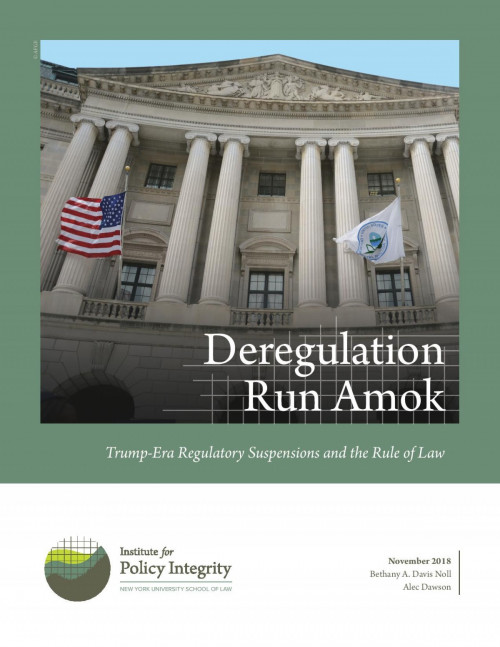-

Deregulation Run Amok
Trump-Era Regulatory Suspensions and the Rule of Law
Our report provides a survey of the legality of Trump Administration’s regulatory suspensions. Looking at a number of cases, we discuss the administration’s disregard for notice-and-comment requirements, statutory restrictions, and the reasoned explanation requirement. We also lay out some of the challenges facing advocates, and the strategies by which agencies have evaded review.
-
Comments to the Interior Department’s Royalty Policy Committee
We recently submitted comments to the Department of the Interior’s Royalty Policy Committee (“RPC”) in advance of the Committee’s third public meeting of the year. As we have discussed in past papers and public comments, existing royalty rates fail to account for the full costs of fossil fuel production, including local and global air pollution.
-
Comments to FERC on a Natural Gas Project EIS
We recently submitted comments to the Federal Energy Regulatory Commission on a natural gas processing and storage facility and marine export terminal in Louisiana, the Calcasieu Pass Project. While the DEIS quantifies the tons of greenhouse gas emissions related to this project—almost 4 million metric tons of carbon dioxide per year from operations, plus hundreds of thousands of tons per year during construction—FERC fails to apply the social cost of greenhouse gas metric to fully account for the climate effects of these emissions. Once again, FERC resorts to flawed arguments used in other inadequate NEPA reviews to implicitly justify why the Commission chose not to use the social cost of greenhouse gases metric for the Calcasieu project. Our comments provide a detailed rejection of FERC’s arbitrary and misleading rationale for failing to use the social cost of greenhouse gases, and offer additional guidance on how to monetize climate effects consistent with the currently best available science and economics.
-
Comments to EPA and Army Corp on Supplemental Notice for Clean Water Rule
Following a Proposed Repeal of the 2015 Clean Water Rule, the Environmental Protection Agency (EPA) and Army Corp of Engineers issued a Supplemental Notice in July 2018 regarding the Proposed Repeal. We previously submitted comments to the agencies on the Proposed Repeal explaining that the economic analysis accompanying that Proposed Repeal was fundamentally flawed. In this notice, the agencies state that they are “not relying” on that economic analysis.
-
Policy Integrity Article Cited in Suit Against Interior’s Royalty Policy Committee
A group of NGOS, led by the Western Organization of Resource Councils, recently filed a complaint in the District of Montana Court regarding Secretary of the Interior Zinke’s Royalty Policy Committee (RPC). The complaint argues that though the RPC should be acting transparently on behalf of American taxpayers, it is in fact working in secret to advance the interest of extractive industries. In the complaint, the petitioners cite a recent Harvard Environmental Law Review article by Policy Director, Jayni Foley Hein, Federal Lands and Fossil Fuels: Maximizing Social Welfare in Federal Energy Leasing, to help make their case.
-
Comments to Interior on San Juan Mine Lease Extension DEIS (New Mexico)
The Department of the Interior is proposing to extend leasing and operations at New Mexico’s San Juan mine by 15 years, producing up to 53 million additional tons of coal that will release 97.5 million tons of greenhouse gas emissions when combusted. In our comments to Interior on its draft environmental impact statement (DEIS) for the mine’s lease extension, we criticize Interior’s failure to fully account for the climate effects related to the project by monetizing the damage these emissions will cause. This refusal leaves the public and decisionmakers in the dark about the climate effects of the project, and is arbitrary given that the agency relies on the project’s monetized benefits to justify its action.
-
Brief to SCOTUS on Economic Impact of Conservation Designations
We recently filed, in a case before the Supreme Court, a brief on the role of ancillary and unquantified benefits in cost-benefit analysis for environmental policy. The Fish and Wildlife Service, in declaring critical habitat designation areas for the dusky gopher frog, decided to not exclude some private land from the designation after qualitatively assessing the direct and indirect costs and benefits of the designation.
-
Brief on Repeal of Interior’s Valuation Rule
In 2016, the Department of the Interior’s Office of Natural Resources Revenue (ONRR) issued the Consolidated Federal Oil & Gas and Federal & Indian Coal Valuation Reform (Valuation Rule). The Valuation Rule sought to ensure that states and the federal government receive the full value of royalties due under the law for oil, gas, and coal extracted from public land. In 2017, ONRR abruptly reversed course and repealed the rule. State attorneys general have now sued ONRR over the repeal and filed a motion for summary judgment. In our brief supporting the plaintiffs, we argue that ONRR did not provide a reasoned explanation for repealing the Valuation Rule, both because ONRR fails to accurately assess the repeal’s economic impact and because ONRR fails to provide a reasoned explanation for its abrupt change in course.
-
Comments to Interior’s Royalty Policy Committee
Our policy director, Jayni Hein, published a new op-ed in U.S. News & World Report on the Interior Department’s failure to protect the public interest in fossil fuel leasing decisions. In addition, she submitted the op-ed as public comments to Interior’s Royalty Policy Committee and gave verbal remarks at its meeting on June 6, 2018. Hein argues that Interior is required by law to earn “fair market value” for the use and development of public natural resources, and that providing royalty rate reductions and other undue concessions would inappropriately transfer public revenue to fossil fuel industry stakeholders.
-
Comments to BOEM on Offshore Wind Program
The Bureau of Ocean Energy Management (BOEM) is responsible for leasing offshore areas for energy development, including areas for wind energy. The agency has so far awarded 13 commercial offshore wind leases, totaling about 17 GW of capacity. In response to its request for feedback on the future of its offshore wind program for the Atlantic Outer Continental Shelf, our comments to BOEM suggest steps toward developing a robust offshore wind program that will deliver benefits to the public for decades to come.
Viewing recent projects in Natural Resources




